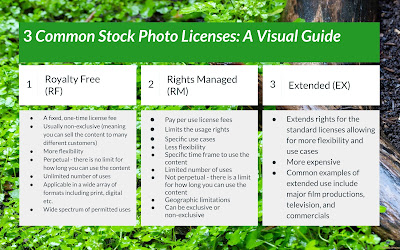What are the Different Types of Common Stock Photo Licenses?
Stock photos are images that you can purchase and use for a variety of purposes including: creating a website, accompanying an article, designing a menu, or in a blog post. The different ways you are able to use a stock image depend on the license type and the rights you are granted. Not all stock photos have the same usage rights and it is important to read your license carefully to understand what you can and cannot do.
This blog will summarize three common stock photo licenses: Royalty Free, Rights Managed, and Extended.
Royalty Free (RF)
Royalty Free is the most prevalent and cost efficient type of stock photo license. It means that you pay a one-time fee to download and use the image perpetually or as many times as you want, for as long as you want, and in a wide spectrum of permitted uses, as long as it follows the terms and conditions of the license agreement. It is important to note that there are restrictions on how you can use the Royalty Free content, so make sure that you read the license carefully.
The main advantage of Royalty Free images over Rights Managed for the customer is that they are flexible, affordable, and hassle-free. You can use them for numerous projects and purposes without worrying about paying extra fees or royalties. You do not have to pay additional royalties to the image owner or the agency each time you use the image. The main disadvantage is that they are non-exclusive, meaning that your other people can license the same image. Exclusive Royalty Free image licenses are occasionally available, but they are usually much more expensive.
Rights Managed (RM)
Rights Managed is a less flexible type of stock photo license. It means that you pay a fee to use the image for a single project, use, or purpose for a set time and in a specific geographic region. There are other limits that may apply. The fee can vary depending on the specific use cases and is calculated by the agency or the image owner.
Rights Managed images offer greater control and protection for how the image
is used, which can be important to the creator. The customer can negotiate the
terms and conditions of the license agreement according to their tailored
needs and budget. Customers can usually request exclusivity rights so that no
one else can use the same image for the same or similar purpose during the
license period. This can ease concerns about your competitors licensing the
same image.
The main drawback of Rights Managed images is that they cost more and are less flexible than Royalty Free images. You will have to pay more for each additional use.
Extended
Extended is another type of stock photo license that grants extra rights that are not included in Royalty Free or Rights Managed licenses. It means that you pay an extra fee on top of the base license fee to extend your rights.
These licenses DO NOT transfer ownership. The creator still maintains the
copyright and ownership of the work. The licenses grant the customer
permission to use the image.
Sources:
- https://marketing.istockphoto.com/blog/image-licensing/
- https://www.stockphotoguides.com/use/using/types-of-stock-photo-licenses
-
https://medium.com/wemark-stories/stock-photo-licenses-explained-27749d56760f
- https://www.default-design.com/3-types-of-stock-image-licenses/?lang=en
- https://www.gettyimages.com/eula
Purchase The Royalty Free License For This Infographic
Stop being confused by stock photo licenses. Clear the air & download your copy of the Ultimate Guide to Common Stock Photo Licenses: Visual Infographic today!


